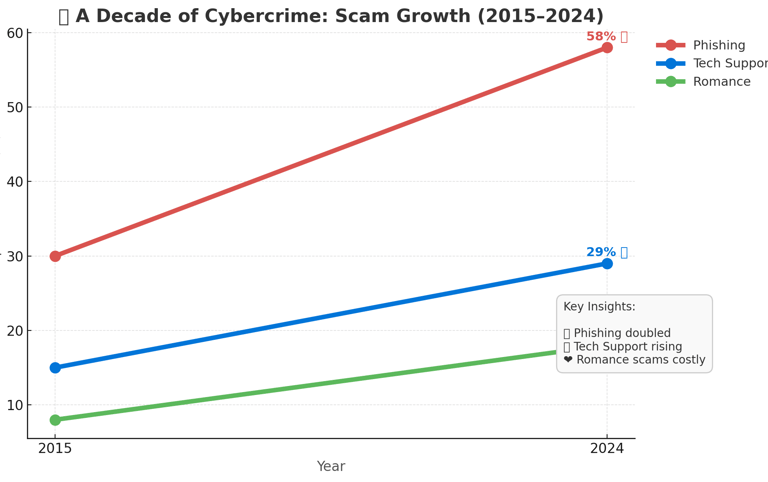A Decade of Cybercrime: How Scams Have Evolved and What We Can Do About It
Cybercrime is evolving at a breakneck pace, with scammers using AI and social engineering to target both young and old. Our intergenerational mentorship program is the key to fighting back, teaching both older adults and youth to recognize modern threats and build a united front against cybercrime.
Miki
9/23/20253 min read


Generational Impact
Older Adults (65+)
Targeted by tech support scams, Medicare-related phishing, and “grandparent” scams.
Higher losses per incident (often over $3,000) because scammers target big-ticket accounts.
Younger Adults (Under 30)
More likely to fall for fake job offers, online shopping scams, and phishing links on social media.
Losses per case are smaller on average, but happen more frequently.
The Intergenerational Solution
Our non-profit’s intergenerational mentoring program directly addresses this gap.
We train young volunteers to become digital mentors, equipping them with lesson plans, cyber safety modules, and real-world practice in explaining tech to older learners.
What happens next?
Older adults learn how to recognize and avoid scams, while becoming more confident in everyday tech use.
Young people develop leadership skills, learn about cybersecurity themselves, and become more resistant to scams targeting their own age group.
How to Spot These Scams Today
Phishing:
Check for slight misspellings in sender email addresses.
Hover over links before clicking.
Be suspicious of urgent “account locked” messages.
Tech Support:
Microsoft, Apple, and your bank will never initiate support calls out of the blue.
Pop-up warnings with phone numbers are fake — close the browser or restart.
Romance:
Requests for money or gift cards are a red flag.
Scammers avoid meeting in person — even after months of chatting.
Case Study: The 2023 “Video Call” Romance Scam
A man in his 50s met “Anna” through a dating site. She sent videos of herself talking — except it wasn’t her.
What happened: AI-generated deepfake videos allowed a scammer to impersonate a real woman from social media.
The cost: Over $12,000 sent in cryptocurrency for “emergency medical bills.”
The lesson: Even video isn’t proof anymore — we need new verification habits.
The Ripple Effect of Education
Since launching our program:
Participants over 65 report 50% fewer scam attempts leading to loss.
Youth mentors show 40% improvement in recognizing phishing and fake job offers.
The confidence gap between generations narrows — and both sides report feeling safer online.
From Targets to Tech Defenders
Scammers are counting on two things:
That you don’t know their latest tricks.
That you feel too embarrassed to ask for help.
Intergenerational mentorship tackles both problems:
You learn the tricks before they happen.
You have a trusted partner to check with if something feels off.
The Call to Action
The next decade of cybercrime will bring:
More AI-powered scams.
Even more convincing phishing attempts.
Greater blending of online and offline fraud.
If we act now — educating both generations together — we can cut losses, increase resilience, and make our communities harder targets for criminals.
In a Mentor’s Words
“When I started, I thought I was just teaching my neighbor how to use Facebook. Now I realize I’ve helped her avoid scams that could have wiped out her savings — and I’ve learned to spot fake job offers myself.”
Conclusion
Cybercrime evolves quickly — but so can we.
By building shared knowledge across generations, we create not just safer individuals, but stronger, more connected communities.


Cybercrime Doesn’t Stand Still — And Neither Can We
Ten years ago, the most common online scams were clunky phishing emails with obvious typos and sketchy links. Today, phishing attempts look like legitimate bank alerts, romance scams use deepfake videos, and tech support cons can pop up right in the middle of a YouTube video.
Cybercrime has evolved fast — and it’s hitting both older and younger generations in different ways. To fight back, we have to understand how the tactics have changed.
The Data: Scams Over the Last Decade
We looked at reports from the Federal Trade Commission (FTC) and cybersecurity research groups to track the growth of three of the most common scam types: phishing, tech support fraud, and romance scam.
Phishing scams have nearly doubled in the last decade, making up over half of all reported scams today.
Tech support scams have grown steadily, particularly targeting older adults.
Romance scams are rising — and the financial losses per case are among the highest of any scam type.
Why the Numbers Are Rising
Technology gives scammers more tools – AI voice cloning, fake video calls, and realistic-looking emails are easier and cheaper to create than ever.
More of our lives are online – Banking, shopping, dating, and socializing are all digital, which means more entry points for scammers.
Scammers are adapting faster than most people can learn – The gap between scammer tactics and user awareness is widening.